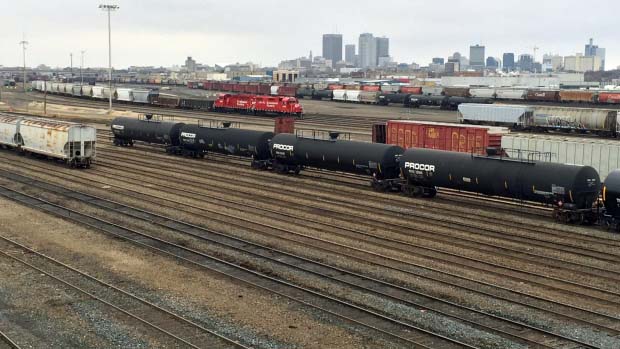
Could Bring Winnipeg Together
Winnipeg Manitoba - The Canadian Pacific Railway (CP) marshalling yards in Winnipeg are huge, over 200 acres of land, with room for a wide
variety of possible uses.
With the relocation of the yards, park land, recreation, rapid transit, housing, services, businesses, and cultural activities could all find homes in the
area, which would then become a vital place for connection in our city instead of a dividing line through it.
The Rail Yard Relocation Project is trying to persuade all three levels of government and private sector investors to proceed with a plan to move the yards and
maximize the area's potential for dynamic development.
It's not our job to decide how that will happen, but let me suggest some of the possibilities to consider.
There is a wonderful park in southwest Winnipeg, but no comparable parkland in central Winnipeg.
Here is the chance.
I have heard reports that the yards are polluted as a consequence of spills of oils and acids of every description for over 100 years, but The Forks, which was
once a rail yard for Canadian National Railway (CN), must have gone through similar abuse, and look at The Forks today.
Green space should not be focused in one large area.
Besides a major park, we must ask our urban planners and designers for small local parks tucked in among a variety of buildings.
Park space is not inert space.
One should find a skating rink in winter months and soccer fields in spring, summer, and fall.
This large tract of land goes from Main Street to McPhillips Street.
It can accommodate a rapid transit route throughout its length.
The eastern end at Main Street is close to city hall, with just a few blocks more to Portage and Main.
Using the railway corridor is the easy way for rapid transit to reach out to the west, to the Richardson International Airport and CentrePort Canada, where
road, rail, and air facilities combine.
I can see a spur line heading north to the Maples.
Wherever there are stations along a rapid transit route, there will be housing in high-density clusters of condominiums and apartment buildings.
There should be housing available for those in high-income and middle-income brackets, but affordable housing should also be in good supply.
This is not a government project, although government is a necessary and welcome partner, there must be opportunities for private-sector
investment.
Entrepreneurs in the service industries, ready to do business, will pop up wherever there are interesting new housing developments for both owners and
renters.
One can expect shops accommodating restaurants, coffee shops, and ice cream parlors, as well as dental offices, medical clinics, and law offices.
There's room for cultural activities, like galleries or theatres.
We have seen the businesses, restaurants, hotels, shops, museums, located at The Forks.
Over time, the same sort of development could take place in the vacated yards.
As with the CN rail line bordering The Forks, it might be possible to retain a rail line in a way that makes it an attraction for residents and users of the
space, and indeed the general public.
How the space becomes attached to existing streets, both north and south of the rail yards, will undoubtedly be explored.
There are spur lines leading off from the yards in both directions.
It will test the imagination of our urban designers to invent spaces that are both interesting and economical.
Salter Street Bridge will soar over the space as usual.
It is not known whether the Arlington Street Bridge will be repaired to do likewise, but left more or less in its current state, it could be fixed up as an
ornamental pedestrian bridge, adding to the delights of the yards.
Care will be taken to ensure the yards are not given over to the automobile.
Yes, there must be some roads to permit what the yards did not allow, which is a connection between communities to the south and north sides of the yards, but
this could become the area where the bicycle is king.
There should be bicycle paths meandering through the park and through all parts of the space.
While it is not the responsibility of the Rail Yard Relocation Project to determine how the land will be zoned and used, it is our task to convince the three
levels of government, and CP, that development of the yards should proceed, and to identify the types of development that have been proven to be effective in
other cities.
What appears in this article is one person's dream of what could be made of the CP marshalling yards, but no promises come with the dream.
More important than what is in the space is what the space will do for the metropolitan area of Winnipeg.
For well over 100 years, the CP yards have been a barrier between north Winnipeg and the rest of the metropolitan area.
I would hope there will be easy access from one side of the rail yards area to the other, that there will be a greater connection between neighbourhoods no
longer on opposite sides of the tracks.
Manitobans who live outside the Winnipeg urban area may feel that too much time, energy, and money will be spent on another Winnipeg project.
They should not begrudge this attention, for the development of the rail yards is the engine of prosperity, not just for Winnipeg, but for all
Manitobans.
It has taken two decades to fully develop The Forks, and the CP rail yards cover a much larger area.
It will take a similar period to realize the area's full potential.
But as the development takes place, there will be tangible growing pride and excitement among all our citizens.
Charles Huband.
under the provisions in
Section 29 of the Canadian
Copyright Modernization Act.


